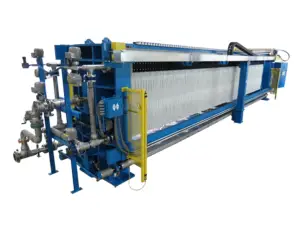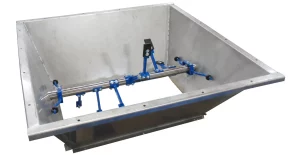Plate and Frame
WHAT IS A PLATE AND FRAME FILTER PRESS?
Plate and frame filter presses have been used for many years, and predate the recessed chamber filter press, which is the type that most people think of today when they hear the term “filter press”. Although recessed chamber presses are now more of the norm, the plate and frame design has some advantages with certain applications and is still used today.

PLATE AND FRAME FILTER PRESS DESIGN OVERVIEW
The plate and frame design utilizes a flat, solid plate (known as a “flush plate”) covered by a filter press cloth, with a hollow frame between each plate. A metal skeleton holds and clamps the filter plates together to create a chamber, which is formed by the flush plate on each side of a frame. Filter cake is collected within the frame. Historically, plates were made of wood or cast iron. Today, the most common material is polypropylene.

HOW DOES A PLATE AND FRAME FILTER PRESS WORK?
The slurry is pumped into a corner hole and flows into each frame, allowing solid particles to accumulate on the filter cloths. The remaining filtered liquid (also known as filtrate) then moves to a drainage port in the flush plate and into a corner hole that is not being used for feeding the slurry. The filtrate then travels to discharge piping and is directed to the next step in the process.
After a period of time, the frames become filled with solids, the slurry feed pump turns off, and the filter press is ready to open. Each frame should now contain a filter cake, which is the end result of the solids forming on the filter cloths. The filter cakes are then scraped out of the frames using a spatula, ideally falling into a cake hopper placed below the press.


ADVANTAGES OF THE PLATE AND FRAME DESIGN
The primary advantages of plate and frame presses are the ability to quickly change the filter cloths as well as the ability to use a wider range of materials for the filtration medium, including paper, which is often used for fine filtration applications.
For example, in a process where immediate particle retention is important, filter paper may be required as fine solids would either blind off the filter cloth or simply pass through it. Note that filter cloths are still in place to support the filter paper. The filter cloths are reused, but the filter paper is replaced after every filtration cycle.
Plate and frame presses are best suited for projects where filtration area is more important than volume. This is why plates and frames have their greatest prominence in polishing applications (as opposed to dewatering projects), where the feed solids concentration is often well below 1% by weight.
Polishing applications are sized for a particular filtration area based on the process flow rate and the known flux rate (volume per area per unit of time). To avoid dips in achievable filtration flow as the press fills with solids, polishing applications usually include a redundant filter press that is also sized to accept 100% of the desired process flow.

DISADVANTAGES OF PLATE AND FRAME PRESSES
One disadvantage of the plate and frame design is the potential for building uneven pressure between frames, which can lead to plate damage. This issue stems from the fact that the frame is being fed through a small opening in the corner, which can lead to blockage. This clogging can cause one frame to become full while the next frame in-line remains empty.
Another disadvantage is the potential for leakage. The filter plates used in plate and frame presses are non-gasketed, which allows them to wick liquid under pressure. This type of filter press is usually mounted on a raised platform or positioned over a pit where any leaked liquids can be collected more conveniently.
Recessed Chamber
WHAT IS A RECESSED CHAMBER FILTER PRESS?
A recessed chamber filter press utilizes filter plates that form a series of cavities between them when they are clamped together. Suspended particulates collect on the filter cloths and build up inside each cavity space to form a filter cake. Compare this to the hollow frames of the plate and frame design where solids are collected.


RECESSED CHAMBER FILTER PRESS DESIGN OVERVIEW
The skeleton of a recessed chamber filter press is constructed in a similar fashion as a plate and frame press where the plates hang on a steel frame, and the frame acts as a clamping device for the filter plates. Both types of presses also utilize a hydraulic cylinder and pump for opening, closing, and clamping the press.
As with plate and frame filter plates, recessed chamber plates are most commonly made from polypropylene. However, recessed chamber plates can be either gasketed or non-gasketed. Gasketed plates offer greater protection from leakage, but can also require a more time-intensive cloth changing process. Non-gasketed cloths or plate and frame cloths can have latex applied to the edges to help minimize (but not eliminate) wicking.

HOW DOES A RECESSED CHAMBER FILTER PRESS WORK?
Slurry is pumped into the filter press through the feed (most commonly in the center of the plate) and the solids are distributed evenly in each chamber throughout the press (1). Solids begin to build on the filter cloths. Most of the solid/liquid separation is accomplished by the particulates building on the cloths. At first, some fines pass through, but eventually the solids begin to form a layer on the cloths (2). This layer traps the fine particles and eventually forms a filter cake. The filter cake then serves as a depth filter as the dewatering process continues.
The filtrate (liquid) usually exits the filter pack (plates) through corner ports into a manifold. When the correct valves in the manifold are open, the filtrate exits the press through a single point, the filtrate outlet. The filtrate is then directed via discharge piping to the next step in the process.
As the filter press builds pressure, the solids build within the chambers until they are completely full of filter cake (3). Once the chambers are full, the fill cycle is complete, and the filter press is ready to be emptied (4). The press is then opened, and the plates are moved apart. As the plates are shifted, the filter cake falls from each chamber into a cake hopper or drum below the press. A spatula can be used to scrape the cake from the cloths if needed.
ADVANTAGES OF THE RECESSED CHAMBER DESIGN
One of the main advantages of the recessed chamber plate design is the ability to feed a large center hole versus a small opening in the corner of the plate. The large hole in the center of the plates allows the chambers to fill faster and more evenly, with less risk of clogging and causing plate damage due to unequal pressure. This is especially important in applications with high feed solids.
However, it’s also important to note that a larger feed inlet (combined with gaining one more filtrate outlet in a center feed configuration) is important in large-scale polishing applications with high flux rates (for example, a Merrill-Crowe process). If the filter plate inlets, outlets, and internal porting are not large enough, the calculated press flow rate will not be achievable.
Another advantage is the ability to achieve higher feed pressure with the recessed chamber design. The “frame” or sealing surface of the recessed chamber plate is all connected to the center web. This keeps the “frame” from bowing out under high pressures.

Also, filter cake release is generally easier with a recessed plate. When the press is opened, and the plates are shifted, the cake either falls out or is quickly scraped off the cloths using a spatula. Cake release may not be as fast with a plate and frame press, as the filter cake is held by a non-tapered frame and may require more manipulation for removal.
DISADVANTAGES OF RECESSED CHAMBER PRESSES
Although recessed chamber presses have several advantages over plate and frame, one disadvantage is the limitation on cake thickness, which is dictated by the depth of the chamber. Recessed chamber plates cannot be easily swapped out for a wider or narrower frame as in a plate and frame press. This makes the plate and frame design better suited for applications where testing variations in filter cake thickness is important.
Another disadvantage can be seen in changing filter cloths. The plate and frame design allows for a simple drape-over cloth, whereas recessed chamber either requires pounding filter cloths into the plates (gasketed) or securing cloths to the plates using cloth dogs and zip ties or hook-and-loop fasteners (non-gasketed).
CONTACT US TODAY
Contact our Sales and Service Team to learn more or request a quote today.
M.W. Watermark, LLC. M.W. Watermark® is a federally registered and protected trademark owned by M.W. Watermark, L.L.C. All rights reserved.


















